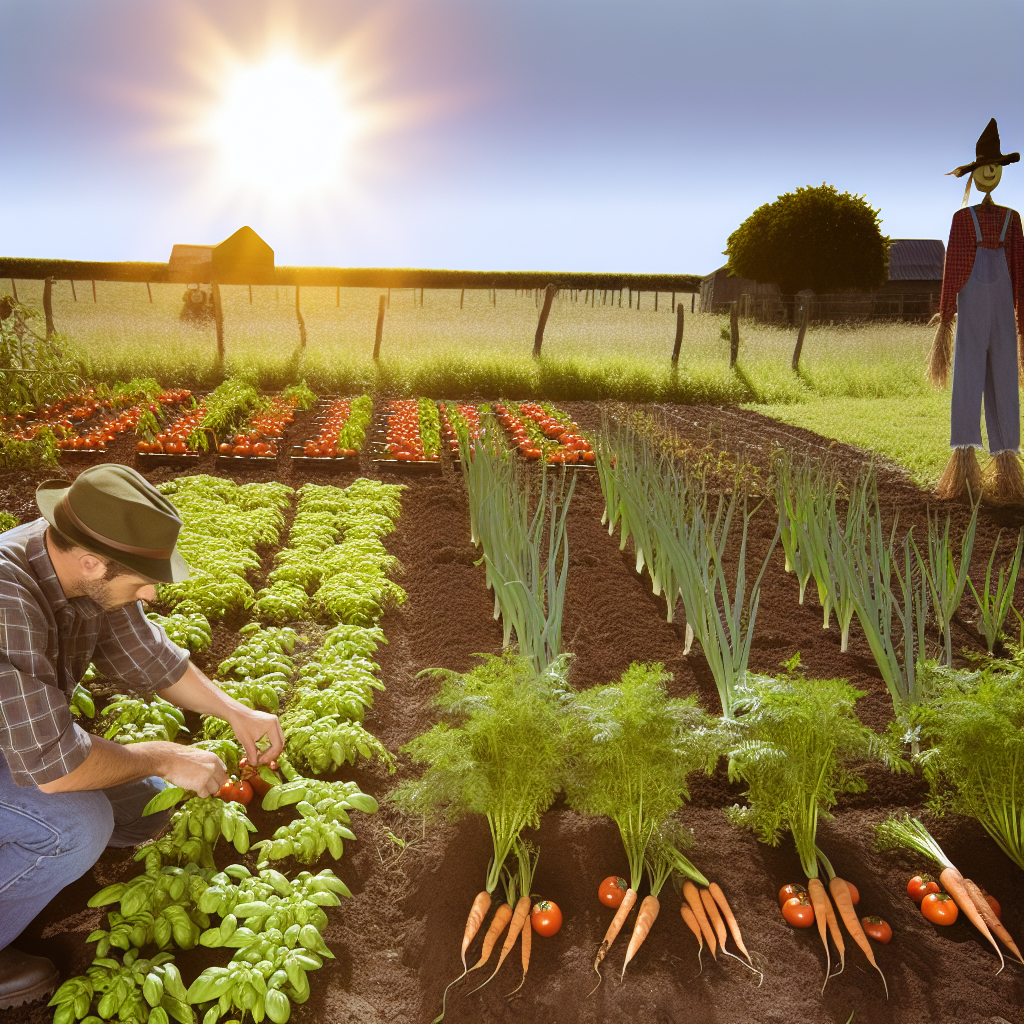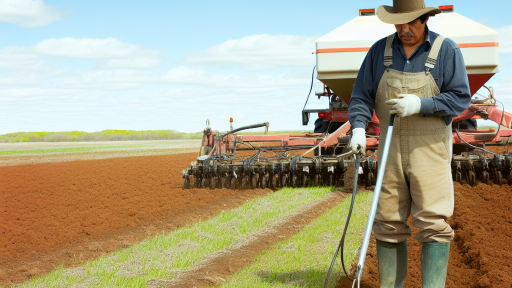Introduction to Companion Planting
Definition of Companion Planting
Companion planting involves growing different plants together for mutual benefit.
It utilizes natural relationships in the garden to enhance growth and health.
This practice draws on the understanding of plant interactions.
Gardeners use it to maximize space and resources effectively.
Benefits of Companion Planting
Companion planting offers numerous advantages for organic farming.
First, it helps deter pests naturally.
Certain plants emit signals that repel harmful insects.
This reduces the need for chemical pesticides.
Second, it promotes healthy growth among plants.
Some plants improve the nutrient uptake of their neighbors.
For example, legumes fix nitrogen in the soil for surrounding crops.
Additionally, companion planting can enhance flavor.
Some plants, when grown together, amplify each other’s taste.
This can lead to improved harvest quality and yield.
Moreover, it helps with pollination.
Transform Your Agribusiness
Unlock your farm's potential with expert advice tailored to your needs. Get actionable steps that drive real results.
Get StartedAttracting beneficial pollinators increases fruit and seed production.
By mixing flowering plants with others, gardeners encourage bees and butterflies.
Finally, companion planting promotes biodiversity.
This practice creates a more resilient ecosystem in the garden.
It fosters a balance that benefits all living organisms.
Essential Principles of Organic Companion Planting
Understanding Companion Planting
Companion planting optimizes space in your garden.
This method involves pairing plants that benefit each other.
Healthy plants support biodiversity and natural pest control.
Moreover, they can enhance soil fertility and water retention.
Choosing Compatible Plants
Select plants with complementary growth habits.
For instance, pairing tall plants with shorter ones maximizes sunlight.
Consider plants that attract beneficial insects.
Examples include marigolds and sweet alyssum.
Utilizing Natural Pest Management
Companion planting creates a natural habitat for predators.
Enemies of harmful pests thrive when plants are mixed well.
This method reduces the need for synthetic pesticides.
Consider adding plants like basil to deter aphids from roses.
Enhancing Soil Fertility
Some plants fix nitrogen in the soil, benefiting surrounding crops.
For example, legumes enrich the soil when planted alongside corn.
Additionally, deeper rooting plants can access nutrients that surface plants cannot.
Therefore, consider diverse root systems in your planting strategy.
Maximizing Space Efficiency
Use vertical gardening techniques to save ground space.
Climbing plants, such as peas and beans, work well with larger plants.
Group plants with similar water and light needs together.
Showcase Your Farming Business
Publish your professional farming services profile on our blog for a one-time fee of $200 and reach a dedicated audience of farmers and agribusiness owners.
Publish Your ProfileFinally, rotate crops regularly to prevent soil depletion.
Maintaining Pest and Disease Balance
Regularly observe your garden for signs of pests or diseases.
Healthy companion plants discourage infestations naturally.
Remove affected plants promptly to reduce disease spread.
In addition, diversify your plantings to lower susceptibility risks.
Top Companion Plants for Key Crops: Vegetables and Herbs
Enhancing Growth with Companion Planting
Companion planting boosts plant health and increases yields.
This method involves growing different plants together for mutual benefits.
Moreover, certain plants repel pests or attract beneficial insects.
Recognizing effective pairings helps gardeners maximize their efforts.
Vegetable Companion Planting
Tomatoes thrive alongside basil.
Basil enhances the flavor of tomatoes and deters unwanted pests.
Next, consider planting carrots with onions.
The two species naturally help each other by reducing nematode problems.
Additionally, beans and corn form a classic synergy.
Beans fix nitrogen in the soil, helping corn grow strong.
Herb Companion Planting
Herbs like dill pair well with cucumbers.
Dill attracts beneficial insects that can fend off cucumber pests.
Furthermore, rosemary is a great companion for cabbage.
This herb repels cabbage moths and enhances cabbage growth.
Finally, mint benefits from being planted with kale.
Mint’s strong aroma deters pests harmful to kale plants.
Flowers as Companion Plants
Marigolds are beneficial in any vegetable garden.
They repel nematodes and other harmful pests effectively.
Sunflowers also serve as great companions for various crops.
They attract pollinators while supporting climbing plants like beans.
Strategies for Successful Companion Planting
Start by planning your garden layout carefully.
Research compatible plants for optimal growth conditions.
Additionally, monitor your garden regularly for signs of success.
Adjust planting combinations based on seasonal changes.
By following these tips, you create a thriving, organic garden.
Delve into the Subject: Top Organic Farming Techniques for Successful Harvests
Companion Planting Techniques: Intercropping and Succession Planting
Understanding Intercropping
Intercropping is a method that involves growing two or more crops in proximity.
This approach maximizes space and resource utilization in the garden.
It promotes biodiversity, which can lead to healthier crops.
Different crops can complement each other by sharing nutrients in the soil.
For example, planting beans with corn can create a mutually beneficial relationship.
Beans fix nitrogen in the soil, benefiting the nutrient needs of corn.
Moreover, this technique can deter pests, reducing the need for chemical treatments.
To successfully implement intercropping, consider crop compatibility.
Research which plants thrive together and which should be kept apart.
Showcase Your Farming Business
Publish your professional farming services profile on our blog for a one-time fee of $200 and reach a dedicated audience of farmers and agribusiness owners.
Publish Your ProfileExploring Succession Planting
Succession planting involves growing multiple crops in the same area in sequence.
This method enhances productivity by maximizing the use of growing seasons.
Plant one crop after another as soon as the previous one is harvested.
For instance, after harvesting radishes, you can plant lettuce in the same space.
This practice keeps the soil active and reduces weed competition.
It also ensures continuous food production throughout the growing season.
Succession planting requires careful planning of planting dates and varieties.
Consider seasons and climate when choosing what to plant next.
Benefits of Companion Planting
Companion planting offers numerous advantages for organic gardeners.
It improves pest management through the natural deterrence of harmful insects.
Additionally, it enhances soil health by encouraging diverse root structures.
This diversity helps prevent soil erosion and nutrient depletion.
Furthermore, companion planting can lead to increased yields and healthier crops.
Ultimately, these techniques foster a resilient and sustainable garden ecosystem.
Practical Tips for Effective Implementation
- Start by assessing your garden space and soil health.
- Choose compatible plant varieties based on their growth habits.
- Experiment with different combinations to observe growth interactions.
- Maintain records to track the success of your planting strategies.
- Be prepared to adapt your approach based on changing conditions.
Explore Further: Types of Cover Crops and Their Uses
Pest Management through Companion Planting
Understanding Companion Planting
Companion planting creates beneficial relationships between plants.
It can enhance growth, deter pests, and improve yield.
For instance, growing marigolds with vegetables can repel harmful insects.
Herbs like basil are known to discourage flies and mosquitoes.
Natural Deterrents for Common Pests
Certain combinations of plants naturally repel specific pests.
Tomatoes paired with basil not only taste great together but also keep pests away.
Similarly, carrots and onions support each other while deterring flies.
Consider planting garlic near roses; it keeps aphids at bay.
Enhancing Biodiversity
Diverse plantings boost ecosystem health and resilience.
Different species attract various beneficial insects.
These beneficial insects can help control pest populations naturally.
Encourage pollinators by planting flowers alongside your crops.
Strategic Plant Placement
Placement of companion plants is crucial for success.
Group pest-repelling plants around the main crops.
Ensure access to sunlight and moisture for all plants.
This strategic arrangement maximizes benefits from companion planting.
Seasonal Considerations
Consider the growing season when implementing companion planting.
Some plants perform better in cooler months, while others thrive in heat.
Carefully match the planting timing for optimum pest management.
Monitoring and Adjusting Practices
Regularly monitor plant health and pest activity in your garden.
This attention enables timely adjustments before problems escalate.
Experiment with different combinations to discover what works best.
An adaptable approach enhances your pest management strategies.
Discover More: Top Cover Crops to Prevent Soil Erosion

Soil Health Improvement with Companion Planting
Enhancing Nutrient Availability
Companion planting contributes significantly to soil health improvement.
Showcase Your Farming Business
Publish your professional farming services profile on our blog for a one-time fee of $200 and reach a dedicated audience of farmers and agribusiness owners.
Publish Your ProfileIt creates a diverse ecosystem that supports beneficial organisms.
This diversity promotes nutrient cycling in the soil.
For example, legumes enrich the soil by fixing nitrogen.
Additionally, deep-rooted plants can bring up nutrients from lower soil layers.
Furthermore, certain plants can repel harmful pests that threaten crops.
Choosing companions wisely can lead to better nutrient availability.
Some plants release beneficial compounds into the soil.
These compounds can enhance nutrient uptake by neighboring plants.
Moreover, companion planting reduces the need for synthetic fertilizers.
As a result, it aligns with organic farming principles.
Incorporating flowers among vegetables can also attract pollinators.
Pollinators improve overall yields by aiding in plant reproduction.
However, proper planning is essential for effective companion planting.
Gardeners should consider the specific needs of each plant.
For instance, some plants prefer full sun while others thrive in shade.
Additionally, planting patterns matter for maximizing space and nutrients.
Companion planting plays a crucial role in enhancing nutrient availability.
This practice not only builds soil health but also promotes sustainable agriculture.
Find Out More: Benefits of Organic Farming for Sustainable Agriculture
Case Studies: Successful Organic Farms Utilizing Companion Planting Strategies
Sunny Acres Farm
Sunny Acres Farm showcases the power of companion planting with tomatoes and basil.
This combination enhances flavor while keeping pests at bay.
Farmers noticed a significant increase in tomato yields directly due to basil planting.
Moreover, the aromatic basil repels aphids and hornworms effectively.
Green Pastures Organic Farm
Located in Vermont, Green Pastures thrives with a three-crop rotation strategy.
They intersperse corn, beans, and squash in the same field.
This method, known as the “Three Sisters,” maximizes space and nutrients.
Corn provides a natural pole for beans to climb while squash covers the ground.
As a result, this synergy promotes healthy growth and minimizes weeds.
Hillside Gardens
At Hillside Gardens, carrots and onions grow side by side for mutual benefits.
Onions repel carrot flies, which are detrimental to carrot crops.
This pairing leads to healthier vegetables and higher yields.
Additionally, the garden includes marigolds to deter nematodes and attract pollinators.
Frogsong Farm
Frogsong Farm specializes in mixed cropping systems featuring leafy greens and edible flowers.
They incorporate nasturtiums alongside lettuce to attract beneficial insects.
These flowers also add beauty and provide edible garnishes to salads.
This approach cultivates a diverse ecosystem that encourages natural pest control.
Blue Sky Farm
Blue Sky Farm employs companion planting for its herb and vegetable garden.
Herbs like dill and cilantro grow alongside cucumbers and beets.
These herbs enhance the flavors of the vegetables while repelling common pests.
Consequently, farmers report improved growth and minimal loss from infestations.
Showcase Your Farming Business
Publish your professional farming services profile on our blog for a one-time fee of $200 and reach a dedicated audience of farmers and agribusiness owners.
Publish Your ProfileCommon Mistakes to Avoid in Companion Planting and How to Correct Them
Overcrowding Plants
Overcrowding your garden can lead to poor plant health.
Plants need sufficient space for air circulation and sunlight.
Ensure you follow spacing guidelines for each species.
Consider using vertical gardening techniques for limited space.
Ignoring Plant Compatibility
Not all plants thrive together in companion planting.
For instance, tomatoes and potatoes should not be planted together.
Research plant pairings that benefit each other’s growth.
For example, beans can enhance nitrogen for corn.
Neglecting Soil Quality
Soil quality plays a crucial role in companion planting success.
Use a soil test kit to check nutrient levels and pH balance.
Amend soil with organic compost to enrich nutrients.
Regularly rotate crops to prevent soil depletion.
Focusing Solely on Aesthetics
Companion planting should prioritize health over looks.
Beautiful arrangements may not yield the best results.
Focus on beneficial traits such as pest control and disease resistance.
For example, marigolds can deter harmful insects effectively.
Ignoring Seasonal Changes
Planting seasons vary for optimal growth.
Pay attention to local climate conditions when planting.
Different plants have unique timing for sowing and harvesting.
Utilize native planting calendars to guide your schedule.
Not Monitoring Pest Dynamics
Pest populations can shift due to environmental changes.
Regularly monitor your garden for pest activity.
Encourage beneficial insects like ladybugs to maintain balance.
Moreover, use organic pest control methods when necessary.
Failing to Observe Growth Patterns
Observe how plants grow relative to each other during the season.
Some companion plants may outgrow others, causing shading.
Adjust plant positions as needed for optimal light access.
Continuously review your layout for future planting seasons.
Disregarding Water Needs
Each plant has different watering needs for success.
Grouping plants with similar requirements is essential.
Overwatering or underwatering can damage plant health significantly.
Consider drip irrigation for efficient water management.
Additional Resources
The Three Sisters of Indigenous American Agriculture | National …
Companion planting for pest management in the vegetable garden …




